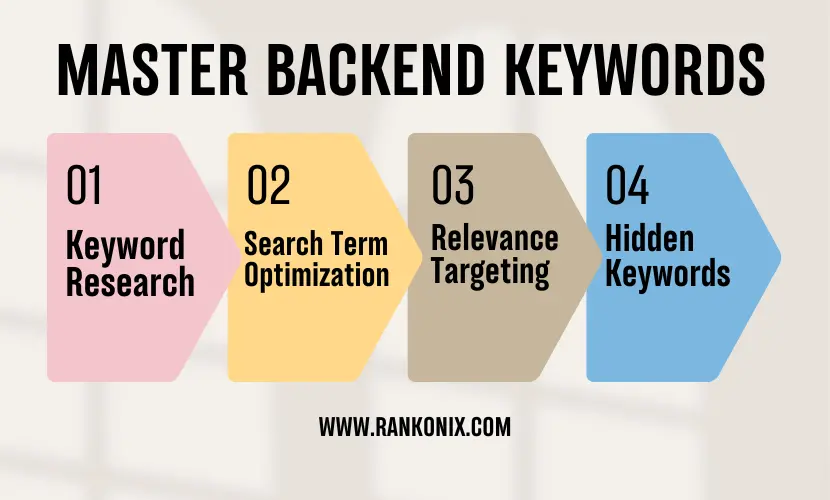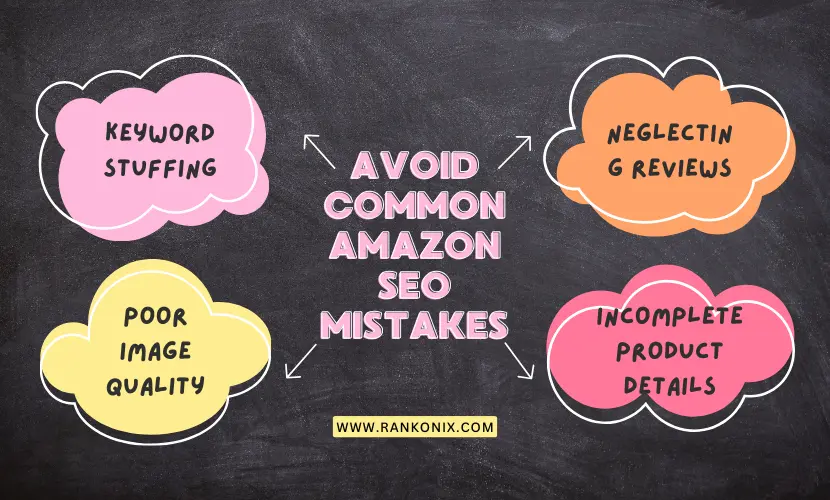Table of Content
Success on Amazon starts with one key factor: visibility. With over 2.5 million active sellers and millions of products competing for attention, standing out is critical to boosting your sales. That’s why SEO Amazon is essential for any seller looking to grow their business on the platform.
Optimizing your product listings for Amazon’s A9 search algorithm can boost rankings, attract more customers, and drive sales. Amazon product SEO focuses on keyword relevance, customer engagement, and performance metrics to help your products rank higher.
Creating keyword-rich titles, bullet points, and optimized descriptions is key to mastering Amazon listing optimization and gaining a competitive edge. Using the right Amazon SEO strategies and tools can further improve your results.
This guide covers 12 proven Amazon SEO tips to boost rankings and stand out in the marketplace. Let’s get started!
What is Amazon SEO and Why Does it Matter?
Amazon SEO (Search Engine Optimization) is the process of optimizing your product listings to rank higher in Amazon’s search results. Using Amazon’s A9 algorithm, the platform evaluates factors like product relevance, sales performance, and customer satisfaction to determine where your listing appears in search results. By improving elements like your product title, backend keywords, and product descriptions, you can boost your organic ranking and attract more shoppers.
With millions of products on Amazon, standing out from the competition is essential. An effective Amazon SEO strategy ensures your products are highly visible to potential customers. Tools like Amazon keyword research tools can help you find high-converting keywords, track trends, and optimize your listings to match customer searches. These optimized listings not only rank higher but also turn views into sales by being more relevant and engaging.
Why is Amazon SEO Important for Sellers?

The importance of SEO on Amazon cannot be overstated. By optimizing your listings, you can increase visibility, improve click-through rates, and boost sales. Compelling and well-optimized product listings are more likely to appear at the top of search results, giving your products an edge in a highly competitive marketplace.
A strong Amazon SEO strategy ensures your products reach the right audience, driving traffic and conversions. Whether you’re an independent seller or a large brand, mastering Amazon product SEO is essential for growth. Using the right keywords and crafting engaging product descriptions can help you stay ahead of competitors.
For consistent growth, higher rankings, and increased revenue, focusing on Amazon SEO optimization is key. Partnering with experts or using advanced tools can give you the edge to thrive in Amazon’s competitive marketplace. Optimize your listings today to maximize your products’ potential!
Amazon SEO Hacks for Maximum Visibility
Want to increase your Amazon sales? Mastering the right SEO Amazon hacks is the key. By optimizing your product listings with effective Amazon SEO Techni, you can boost your product visibility, attract more traffic, and stay ahead of your competitors. In this guide, we’ll share 12 proven Amazon SEO hacks to help you rank higher, drive more sales, and grow your business. Ready to take your Amazon success to the next level? Let’s get started!
1. Start with Smart Keyword Research
Keyword research is the foundation of a strong SEO Amazon strategy. Without targeting the right keywords, your product listings might never reach the right audience. Customers use specific search terms, and understanding these terms allows you to align your product with their intent.
Using Amazon SEO tools like Helium 10 or Jungle Scout, you can uncover high-performing keywords with low competition. Look for keywords that resonate with your product’s niche, focusing on long-tail terms that reflect buyer intent. For instance, if you’re selling a yoga mat, keywords like “eco-friendly yoga mat” or “non-slip yoga mat for beginners” could attract more targeted traffic than broad terms like “yoga mat.”
- Pro Tip: Regularly update your keyword list based on seasonal trends and competitor analysis to ensure your Amazon organic search ranking stays strong.
2. Craft Killer Product Titles
Your product title is the first thing shoppers see, making it a critical component of Amazon product SEO. A compelling title not only captures attention but also improves your visibility in search results.
For effective Amazon product title optimization, include your primary keyword near the beginning of the title. Supplement it with additional details like product attributes, such as size, color, material, and unique features. For example:
Bad Title: Yoga Mat
Optimized Title: Eco-Friendly Non-Slip Yoga Mat – 6mm Thick, Purple, for Beginners
This approach ensures your title is informative and keyword-rich, aligning with both customer needs and Amazon SEO techniques. However, keep your title concise and within Amazon’s character limits (usually 200 characters) to avoid truncation.
- Key Tip: Titles with relevant keywords not only improve your Amazon organic search ranking but also encourage clicks, boosting your overall performance.
3. Optimize Bullet Points for Better Engagement
Bullet points are your opportunity to communicate your product’s unique selling points quickly and effectively. Many buyers scan rather than read, so your bullet points should be concise, engaging, and keyword-rich to support your Amazon SEO efforts.
For successful Amazon product SEO, include keywords like “Amazon SEO tools” or “Amazon product title optimization” naturally in your bullet points. Structure each point to highlight a key feature followed by a benefit. For example:
- Feature: Non-slip texture for extra grip
- Benefit: Stay safe and stable during intense yoga sessions
Additionally, use action words and customer-centric language to make your product appeal to buyers. This strategy not only improves readability but also enhances your Amazon organic search ranking by addressing what matters most to your audience.
- Pro Tip: Don’t forget to include additional details like warranty, care instructions, or compatible accessories for better conversion rates.
4. Master Backend Keywords

While backend keywords aren’t visible to customers, they are crucial for your SEO Amazon efforts. These hidden keywords give you extra opportunities to optimize your listings without cluttering your visible content.
In the backend keyword section, include alternative spellings, synonyms, and even misspellings of your target keywords. For instance, if your main keyword is “Bluetooth headphones,” consider backend terms like “wireless headphones,” “Bluetooth headset,” and “Bluetooth headphones” to cover all variations. This practice strengthens your product visibility by ensuring your product appears in searches you might have otherwise missed.
Backend keywords are also a great place to include niche-specific terms or regional spellings. However, be mindful of Amazon’s guidelines—don’t repeat words, use special characters, or include irrelevant terms, as these can negatively impact your Amazon organic search ranking.
- Hack: Tools like AMZ Tracker or Helium 10 can help you audit and optimize your backend keywords effectively.
Pro Tip: Avoid large blocks of text. Use bullet points, headings, and short paragraphs to improve readability. A clear layout boosts customer engagement, which helps improve your Amazon organic search ranking over time.
5. Leverage High-Quality Product Images
Images are essential for improving SEO Amazon. While they don’t directly impact search rankings, they heavily influence customer behavior by driving higher click-through rates (CTR) and conversions. These are critical factors Amazon uses to rank products in search results.
To improve your Amazon product listing SEO, always use high-quality, high-resolution images that showcase your product from multiple angles. Include close-ups and lifestyle images that show the product in use, highlighting key features and benefits. These visuals not only make your product more appealing but also help customers make informed purchasing decisions, increasing your conversion rate.
Amazon SEO tip: Don’t overlook the importance of alt text. While not visible to shoppers, Amazon’s algorithm uses it to understand your images. Add descriptive keywords in your alt text, such as “stainless steel water bottle for hiking” or “wireless Bluetooth earbuds with noise cancellation.” This aligns with Amazon search ranking best practices, making your product more discoverable in organic searches.
By optimizing your product images and alt text, you can enhance both your product’s appeal and its visibility in Amazon search results.
6. Write Compelling Product Descriptions
Your product description is your chance to boost sales and improve your Amazon SEO ranking. A well-written description not only drives conversions but also helps your product stand out in Amazon search results. Use this space to solve customer pain points, highlight your product’s unique features, and motivate buyers to take action.
Incorporate your focus keyword (SEO Amazon) naturally, along with related terms to improve visibility. Focus on showing how your product solves real problems rather than just listing features. For example:
- Avoid: “Battery lasts 12 hours.”
- Instead: “Stay connected all day with our 12-hour battery life Bluetooth earbuds, designed for comfort and durability.”
Key tips for writing effective product descriptions:
- Use bullet points to highlight key features and benefits.
- Include headings and short paragraphs to make the text easy to read.
- Answer common customer questions to build trust and reduce hesitation.
Clean, scannable layouts not only enhance customer engagement but can also improve your Amazon organic search ranking. Use your product description to tell a story that resonates with your audience and drives results!
7. Harness the Power of A+ Content
A+ Content is a powerful tool for brands enrolled in Amazon’s Brand Registry program. It allows you to add rich visuals, comparison charts, and enhanced product descriptions that go beyond standard listings. This feature significantly improves your Amazon SEO by increasing customer engagement and conversions.
Boost sales and improve your Amazon rankings with A+ Content! Use visually engaging elements like infographics to highlight your product’s key features or comparison charts to show why your product is better than the competition. Tell your brand story with a “how-to-use” section or share your company’s history to build trust and connect with shoppers on a personal level.
Amazon SEO Tip: A+ Content not only increases conversion rates but also helps improve your Amazon organic search rankings. Amazon rewards products with higher performance, so make sure to include relevant keywords in your A+ Content descriptions to maximize your visibility. Enhance your Amazon SEO strategy and drive more traffic to your product listings today!
8. Price Competitively Without Losing Value
Amazon’s algorithm prioritizes products with strong conversion rates, and your pricing strategy is a key factor in driving those conversions. While undercutting competitors might seem like a good idea, pricing too low can hurt your product’s perceived value and brand image. The secret is to find the right balance between competitive pricing and maintaining a high-quality reputation.
To stay ahead, use tools like Keepa or SellerApp to track competitor pricing, monitor market trends, and adjust your strategy. Make smart price changes during seasonal promotions, high-demand periods, or when launching new products to maximize sales and visibility.
How pricing impacts Amazon SEO: Competitive pricing improves your click-through rate (CTR) and conversion rate — two factors that directly affect your Amazon search rankings. The A9 algorithm rewards consistent, high-performing sellers with better visibility, making pricing an essential part of your Amazon SEO strategy. By getting your pricing right, you can boost sales, improve rankings, and grow your business on Amazon.
9. Earn More Reviews and Ratings
Reviews and ratings aren’t just social proof—they directly influence your SEO Amazon performance. Amazon’s algorithm prioritizes products with higher ratings and more reviews because they indicate trustworthiness and customer satisfaction. Positive reviews also improve your Amazon organic search ranking by boosting conversion rates.
Encourage customers to leave reviews through follow-up email sequences, product inserts, or Amazon’s “Request a Review” button. Highlight your customer service efforts, as a good post-purchase experience increases the likelihood of positive feedback.
Pro Tip: Use Amazon SEO tools to monitor reviews and address negative feedback quickly. Prompt resolution of issues not only improves your ratings but also strengthens your brand image.
SEO Impact: Products with a steady flow of positive reviews have a higher chance of being featured in Amazon’s “Best Sellers” or “Customers Also Bought” sections, reinforcing your Amazon SEO strategy.
10. Use Sponsored Ads to Boost Organic Rankings
Amazon-sponsored ads are a powerful way to gain visibility, especially for new products or highly competitive niches. While ads themselves don’t directly affect your SEO Amazon, they drive traffic and sales to your listing, which indirectly improves your Amazon organic search ranking.
By using Sponsored Products, Sponsored Brands, or Sponsored Display ads, you can target specific keywords or customer segments. Focus on bidding for keywords uncovered during your Amazon keyword research to attract relevant traffic.
Hack: Combine your ad campaigns with strong Amazon SEO techniques. For instance, ensure your product title, bullet points, and descriptions are fully optimized before launching ads. This way, the increased traffic from ads translates into higher conversions and long-term organic ranking improvements.
Pro Tip: Regularly analyze your ad performance using Amazon SEO tools like Sellics or Jungle Scout to identify top-performing keywords and adjust your bids accordingly.
11. Monitor and Adapt with Amazon SEO Tools
Amazon’s marketplace is dynamic, with frequent algorithm updates, changing customer preferences, and shifting trends. To stay ahead, use reliable Amazon SEO tools like AMZ Tracker, Sellics, or Helium 10 to monitor your performance and adapt your strategy.
These tools can help you track your Amazon organic search ranking, identify underperforming keywords, and analyze your competitors’ strategies. For example, if a keyword isn’t driving traffic, replace it with a better-performing one from your Amazon keyword research.
Pro Tip: Schedule regular listing audits to ensure your Amazon product SEO remains competitive. Monitor trends in your niche and adjust your backend keywords, product descriptions, and images as needed.
SEO Amazon Tip: Staying proactive ensures your listing maintains its ranking and visibility, even as the market evolves.
12. Avoid Common Amazon SEO Mistakes

Even small missteps can derail your SEO Amazon efforts. Common mistakes include keyword stuffing, which makes your content unnatural and hurts readability, or neglecting Amazon product title optimization, which is a critical ranking factor.
Avoiding common mistakes on Amazon requires careful attention to detail. When crafting titles, keep them concise, include primary keywords, and ensure they stay within Amazon’s character limits. Overlooking backend keywords is another frequent misstep—leaving this section incomplete means missing out on valuable search visibility.
Important Note: Low-quality images and overly complicated descriptions can drive potential buyers away, ultimately harming your Amazon organic search ranking. Adhering to Amazon’s content guidelines is essential to maintain compliance and maximize visibility.
Pro SEO Tip: Focus on Amazon SEO strategies that enhance the customer experience. The algorithm increasingly favors products that provide genuine value to buyers, so prioritizing user satisfaction is key.
Conclusion
Mastering SEO Amazon is more than just a tactic; it’s a game-changing strategy for driving visibility, conversions, and long-term success. By implementing these 12 powerful hacks, you’ll position your products at the top of Amazon organic search rankings, ensuring they’re seen by the right customers at the right time. Whether you’re optimizing titles or refining your descriptions, every small improvement adds up to significant results.
Ready to scale your Amazon business? Visit Rankonix.com for expert guidance on Amazon product SEO and tailored strategies to skyrocket your sales. Let us help you implement cutting-edge Amazon SEO techniques that deliver measurable results. Don’t wait—get in touch with us today and take the first step toward boosting your Amazon success!
FAQs
Q. What are some key tips for Amazon product title optimization?
Effective Amazon product title optimization involves using primary keywords early in the title, adding relevant details like size, color, and material, and keeping it within Amazon’s character limits. An optimized title improves click-through rates and helps align your product with customer search intent.
Q. What are backend keywords, and how do they affect Amazon SEO?
Backend keywords are hidden search terms that help your product appear in more searches. While they’re not visible to customers, they are critical to Amazon product SEO, as they allow you to target additional keywords and improve your Amazon organic search ranking.
Q. How often should I update my Amazon SEO strategy?
It’s essential to update your Amazon SEO strategy regularly to stay ahead of competition and adapt to market trends. Use Amazon SEO tools to monitor performance, track keyword trends, and make adjustments as needed to maintain a strong Amazon SEO foundation.
Q. Can an optimized product listing guarantee higher sales?
While Amazon SEO increases your product’s visibility, higher sales depend on multiple factors, including pricing, images, and reviews. A strong Amazon SEO approach paired with engaging content and competitive pricing creates the best opportunity for increased sales.










Leave A Comment